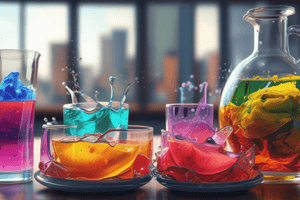Podcast
Questions and Answers
Which of the following is a chemical change?
Which of the following is a chemical change?
- Water evaporates off a hot stovetop.
- Rocks become smooth when they tumble in the surf.
- A metal bridge turns brown as it rusts. (correct)
- Hot wax is poured into a candle mold.
N2 is what type of chemical?
N2 is what type of chemical?
- Compound
- Mixture
- Element (correct)
If Cu+1 loses an electron, what will be formed?
If Cu+1 loses an electron, what will be formed?
Cu+2
What happens to the electrons when a metallic bond is formed?
What happens to the electrons when a metallic bond is formed?
Which of these elements has properties most similar to those of strontium (Sr)?
Which of these elements has properties most similar to those of strontium (Sr)?
Which of the following statements about metalloids is true?
Which of the following statements about metalloids is true?
In which category does a shiny, malleable, ductile element that conducts electricity well MOST LIKELY belong?
In which category does a shiny, malleable, ductile element that conducts electricity well MOST LIKELY belong?
If 10 g of aluminum reacts with 39 g of chlorine, how many grams of aluminum chloride will form?
If 10 g of aluminum reacts with 39 g of chlorine, how many grams of aluminum chloride will form?
How much liquid water is present when a 100 g ice cube melts?
How much liquid water is present when a 100 g ice cube melts?
Which statement is true about chemical and physical changes?
Which statement is true about chemical and physical changes?
What happens to the motion and kinetic energy of particles as temperature increases?
What happens to the motion and kinetic energy of particles as temperature increases?
Which of the following processes results in an increase in the motion and kinetic energy of particles?
Which of the following processes results in an increase in the motion and kinetic energy of particles?
Why can wearing damp clothes make you feel cold?
Why can wearing damp clothes make you feel cold?
When butane burns, it undergoes a chemical change.
When butane burns, it undergoes a chemical change.
What type of bond forms when electrons are shared?
What type of bond forms when electrons are shared?
Which period is molybdenum (Mo) in?
Which period is molybdenum (Mo) in?
Which of the following elements is a metalloid?
Which of the following elements is a metalloid?
Why does an inflated balloon expand when placed in the hot sun?
Why does an inflated balloon expand when placed in the hot sun?
What substances are reactants in the reaction 2H2O2 → 2H2O + O2?
What substances are reactants in the reaction 2H2O2 → 2H2O + O2?
Salt dissolving in water is considered a chemical change.
Salt dissolving in water is considered a chemical change.
What type of bond holds bronze together?
What type of bond holds bronze together?
Which of the following elements are metals?
Which of the following elements are metals?
Study Notes
Chemical Changes and Elements
- A metal bridge turning brown as it rusts is an example of a chemical change.
- Nitrogen gas (N2) is classified as an element, not a compound or mixture.
- Copper ion (Cu+1) becomes Cu+2 when it loses an electron.
Bonding and Metals
- In metallic bonding, electrons float freely in an electron sea.
- Elements like strontium (Sr) are similar in properties to calcium (Ca).
- Metalloids possess a shiny appearance and intermediate conductivity, distinguishing them from metals and nonmetals.
Physical and Chemical Reactions
- A sample identified as shiny, malleable, ductile, and a good conductor most likely belongs to the metal category.
- In a balanced reaction example with aluminum and chlorine, 49 g of aluminum chloride (AlCl3) are produced from 10 g of aluminum and 39 g of chlorine, demonstrating mass conservation.
- Ice melting maintains mass; 100 g of ice yields 100 g of liquid water.
Conservation Laws
- Matter is conserved in both chemical and physical changes, refuting the notion that it is only conserved in physical changes.
- When temperature increases during a chemical reaction, the kinetic energy and motion of particles also increase.
Evaporation and Temperature Effects
- Processes such as melting and evaporation elevate kinetic energy and motion of particles.
- Wearing damp clothes feels cold because evaporating water absorbs heat from the body.
Types of Chemical Changes
- Burning butane in a lighter is classified as a chemical change.
- Covalent bonds are formed when electrons are shared between atoms.
Periodic Table and Properties
- Molybdenum (Mo) is found in period 5 of the periodic table.
- Arsenic (As) is identified as a metalloid among given elements.
Gas Expansion and Reactants
- Increases in temperature cause gas particles in an inflated balloon to expand, making the balloon larger.
- The reactant in the decomposition of hydrogen peroxide (H2O2) is solely H2O2.
Changes in State
- Dissolving salt in water constitutes a physical change, not a chemical one.
- Bronze is an alloy held together by metallic bonds, resulting from the combination of copper and tin.
Identifying Metals
- Calcium (Ca), aluminum (Al), and manganese (Mn) are recognized as metals on the periodic table.
Studying That Suits You
Use AI to generate personalized quizzes and flashcards to suit your learning preferences.
Description
Test your knowledge on the behavior of matter with these flashcards focused on chemical changes and compounds. Learn to differentiate between various types of chemical reactions and bonding concepts. Perfect for students studying integrated physical science.




